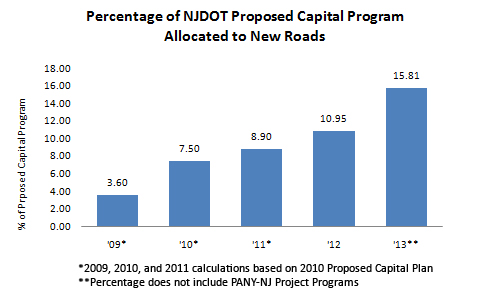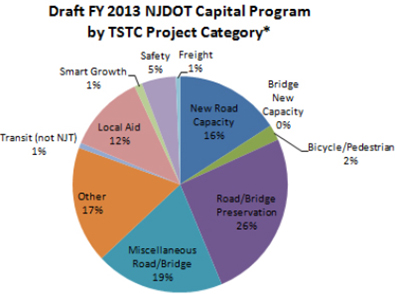
[This post was modified on September 19, 2012]
A new Tri-State analysis [pdf] of NJDOT’s fiscal year 2013 proposed capital program shows that funds for new road capacity have grown almost fourfold since 2009.
Although the state has a backlog of infrastructure needs on its bridges, roads, and transit systems, funding for new road capacity has nearly quadrupled. The report called on the state to better allocate its funds for existing transportation infrastructure needs.
Transit, along with NJDOT grant programs supporting livable communities, fares much better in the proposed 2013 program compared to last year, however. NJ Transit received a 3% increase in funding while funding for Transit Villages was fully restored to $1 million and Safe Streets to Transit was increased to $1 million.
Last year, the Transit Village program was entirely cut and Safe Streets to Transit was funded at $500,000. The Campaign praised NJDOT for restoring the Transit Village funds and increasing funds for Safe Streets to Transit.

Spending on roadway and bridge maintenance still makes up the largest portion of the proposed budget, while funding for new construction is the highest it has been since 2004. Since 2009, funding for new road capacity projects has increased by almost 400%—a troubling trend highlighted by the Campaign in previous years.
The analysis notes that three projects make up 92% of the spending on highway expansion. Large projects, like Direct Connection, force the agency to dramatically shift its funds from maintaining existing road and bridge infrastructure. By prioritizing fix-it-first projects, the agency can more fairly balance the state’s transportation needs within a limited funding scenario.
Four themes emerged from Tri-State’s analysis:
- New road capacity projects make up an increasing share of NJDOT’s capital program. In 2013, these types of projects will consume nearly 16% of the agency’s proposed capital program, up from almost 11% in 2012 and up almost 400% since 2009. Three large projects make up 92% of the spending in this category.
- Future funding uncertainties await NJDOT if new sources of revenue are not identified. The capital program is heavily reliant on annual “one-shot” revenue sources, which will end in 2016, and new debt.
- Spending on bicycle/pedestrian projects has decreased from 2.7% in the 2012 proposed capital program down to 2.4%.
- Support for transit and livable communities has increased, though it remains inadequate to meet demand.
The report calls attention to funding uncertainties looming over the agency. This year’s “one shot” of $353 million from the Port Authority of New York & New Jersey and $260 million from the New Jersey Turnpike Authority—funds originally intended for the cancelled Access to the Region’s Core project—pays for 30% of the projects in the capital program. This funding will disappear after 2016.
Spending on bicycle and pedestrian projects decreased from last year, when it comprised 2.7% of the proposed capital program. The report encourages the state to increase funding to these kinds of projects, since they are popular with New Jersey residents and can have tangible benefits in safety and reducing pedestrian fatalities.
The report offers the following recommendations for New Jersey’s governor, legislature, and department of transportation:
- Recommit to the state’s fix-it-first policy mandated in 2000. Carefully review proposed road expansion projects and call off projects that will not offer sustainable congestion relief. Instead, reprioritize these funds to reduce the state’s backlog of deficient bridges and road maintenance projects.
- Find new, sustainable revenue sources to plug the capital program gap after 2016. Overreliance on debt, exacerbated by the recent sweep of $260 million from the 2013 transportation capital program, is a short-term solution to a long-term problem.
- Restore, and if possible, increase funding for bicycle/pedestrian projects. Focus funding in communities that have passed complete streets policies or in places with the highest number of pedestrian or bicyclist injuries and fatalities.
- Recommit to projects that prioritize main streets, downtowns, and mixed-use transit-oriented development. New Jersey has been a smart growth leader in the past. However, the state has recently lagged in funding smart growth initiatives.
To read Tri-State’s press release, click here [pdf].

[…] Jersey residents would be better served if the State invested in projects that prioritized the maintenance of existing transportation infrastructure (i.e. return to the fix-it-first policy, especially post-Sandy), increased transit service and […]